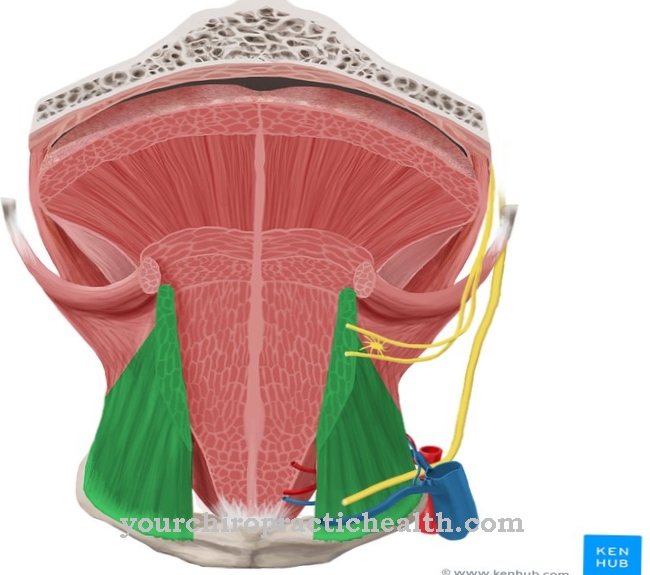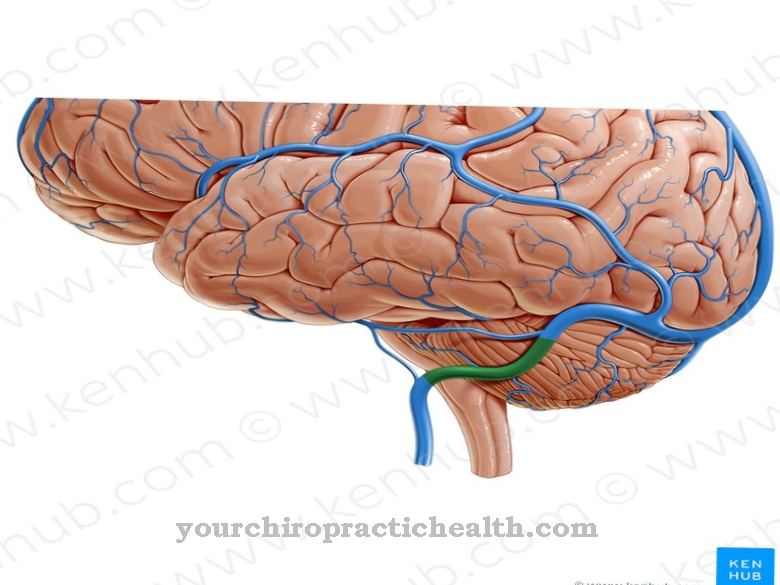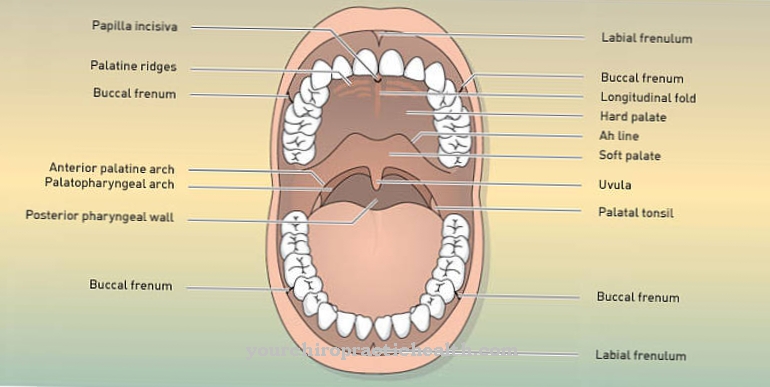The Ethmoid cells are part of the ethmoid bone, which is located in the inner area of the frontal, nasal and eye sockets. In addition to the stability function, they have a connection to the nerves and are involved in smell perception. Fractures, nerve damage, tumors, inflammation and the formation of polyps can be possible diseases in connection with ethmoid cells.
What are ethmoid cells?
The ethmoid cells (Cellulae ethmoidale) belong to the ethmoid bone (Os ethmoidale), which is a bony area in the brain skull and the eye and nasal cavity. The name is based on the sieve-like structure of the holey bone. They are not "cells" in the medical-biological sense, but describe the air-filled cavities. The totality of ethmoid cells is also known as the ethmoid labyrinth (Labyrinthus ethmoidalis).
Anatomy & structure
From an anatomical point of view, the ethmoid bone is located in an area that protrudes into and delimits both the frontal sinus and the nasal and eye sockets. As a bony branch, the ethmoid cells are penetrated by chambers or cavities (pneumatization spaces).
The ethmoid bones are thin-walled and relatively large with holes. There are about eight to ten ethmoid cells adjacent to the frontal sinus. The ethmoid cells are innervated in the broader sense via branches of the fifth cranial nerve (trigeminal nerve). On the one hand, nerve cords extend through the posterior ethmoid cells into the eye socket and connect there to the paired optic nerve (optic nerve). On the other hand, the nerve cords of the anterior ethmoid cells extend over the ethmoid plate (lamina cribrosa) into the nasal cavity (nervus nasociliaris).
The lamina cribrosa is one of the four different bone plates (laminae) of the ethmoid bone. The pneumatization spaces of the paranasal sinuses are lined with mucous membrane and ciliated epithelium. In the nasal passage, the nasal mucous membranes are supplied by the ethmoid cells through the corresponding nerves.
Function & tasks
The ethmoid as a whole is responsible for the stability between the regions involved (base of the skull, eye socket, nasal cavity). At the same time, it divides the areas, such as the base of the skull from the nasal cavity. Or the middle ethmoid bone, which together with the ploughshare bone (vomer) forms the nasal septum. It separates the anatomical structures. The olfactory system is directly related to the ethmoid cells.
Our olfactory perception comes about through the olfactory nerves, which are connected to the olfactory bulb (bulb olfactorius) and the nasal cavity via the cavities of the ethmoid plate. The cavities in the ethmoid plate make it possible for the nerves to pass through, and thus for olfactory perception. Once the smell is detected through the nose, or more precisely through the olfactory receptor cells on the nasal mucosa, the stimulus is passed on to the cerebral cortex via the olfactory bulb. Via the branched connection with the fifth cranial nerve, the ophthalmic nerve (ophthalmic nerve) and nerve branches of the upper jaw (maxillary nerve) and lower jaw (mandibular nerve) are involved, which is responsible, among other things, for the chewing movement. Thus the ethmoid cells play an important role in the transmission of stimuli.
Diseases
Diseases that affect the ethmoid cells can be caused by anatomical malformations that can lead to chronic diseases.
The ethmoid bone cells can also be affected by fractures of the bone plates, diseases of the nerve structures and infections and complaints caused by bacteria and viruses. It should not be forgotten that allergic reactions can also trigger inflammation. Since the ethmoid bone is located in a sensitive area that can be accessed through various routes, the regions involved are particularly susceptible to diseases. The best known disease is inflammation of the sinuses (sinusitis). A distinction is made between acute and chronic sinusitis. The ethmoid cells are part of the paranasal sinuses (sinus paranasales). Viruses, bacteria or allergies inflame the mucous membrane of the paranasal sinuses and encourage swelling.
As a result, suppuration can occur. If pus is encapsulated in a cavity, it is called empyema. The paranasal sinuses also include the maxillary sinus, the sphenoid sinus and the frontal sinus. These regions can be affected as the inflammation progresses. The disease of all parts of the paranasal sinuses is called pansinusitis. Antibiotics, local or oral cortisone preparations and special nasal rinses are used to treat sinusitis. If the disease is so advanced that medication does not improve it, surgery may be indicated.
In the case of polyp formation (tissue proliferation), removal of the ethmoid cells (ethmoidectomy) or partial surgical rehabilitation (removal of the increased mucous membrane, polyps) is indicated. Inflammatory processes that spread through the eye and frontal sinuses to the brain are dangerous. A bacterial infection of the frontal sinus can lead to meningitis. An early diagnosis of symptoms can prevent such a rising inflammation. Anatomical malformations can also promote chronic inflammation. Fractures or injuries to the base of the skull and the ethmoid bone plates increase the risk of CSF leakage. Inflammation can occur in the maxillary sinus area.
Inflammation of the roots of the tooth or purulent abscesses are often the cause of other diseases of the maxillary and paranasal sinuses. The connection between the upper jaw and the cranial nerve runs through the maxillary nerve. Diseases of the nerve conduction of the ethmoid cell system include neuralgia, such as trigeminal neuralgia: a facial pain that is triggered by the fifth cranial nerve (trigeminal nerve) and is often caused by a sinus infection. Diseases related to ethmoid cells are also tumors and cyst formations that impair nasal breathing and the natural drainage of secretions. Ethmoid cells belong to a complex structure in which eyes, brain, smell, chewing, and breathing are indirectly involved and diseases that are connected with them can be just as far-reaching.



























